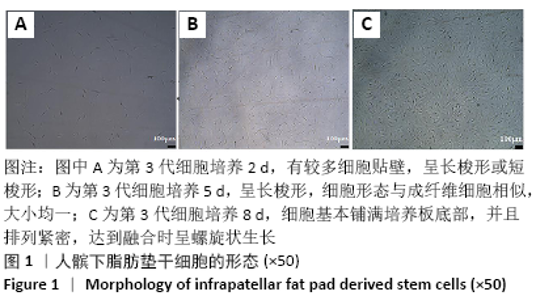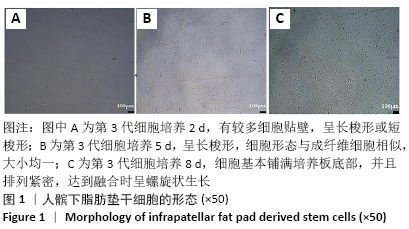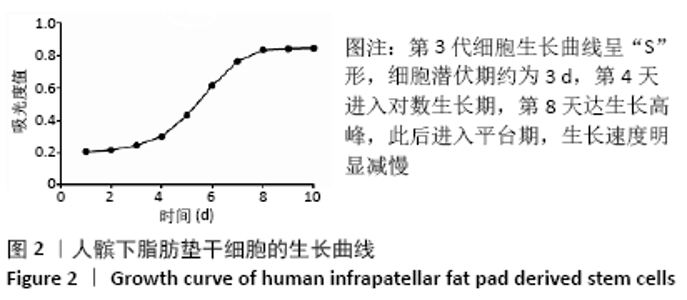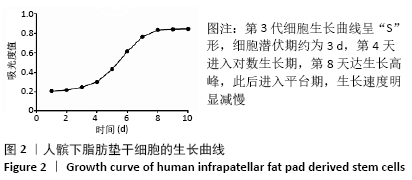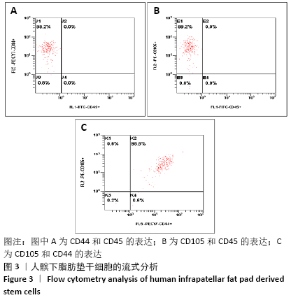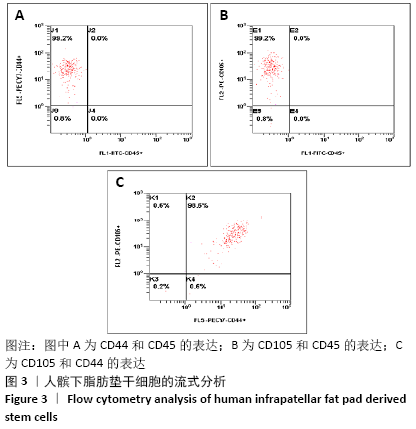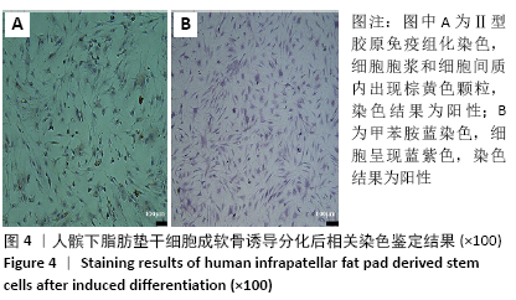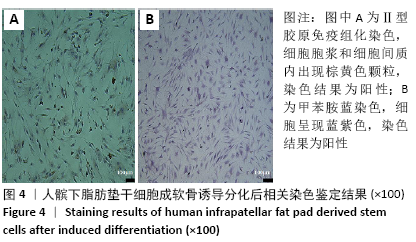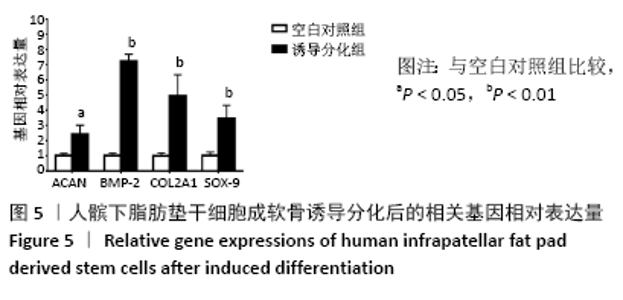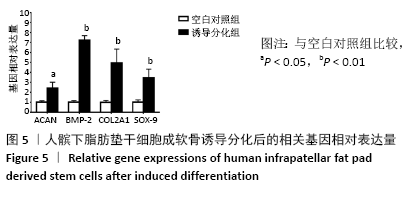[1] TOFIÑO-VIAN M, GUILLÉN MI, PÉREZ DEL CAZ MD, et al. Microvesicles from Human Adipose Tissue-Derived Mesenchymal Stem Cells as a New Protective Strategy in Osteoarthritic Chondrocytes. Cell Physiol Biochem. 2018;47(1):11-25.
[2] BRANLY T, BERTONI L, CONTENTIN R, et al. Characterization and use of Equine Bone Marrow Mesenchymal Stem Cells in Equine Cartilage Engineering. Study of their Hyaline Cartilage Forming Potential when Cultured under Hypoxia within a Biomaterial in the Presence of BMP-2 and TGF-ß1. Stem Cell Rev Rep. 2017;13(5):611-630.
[3] 王兆飞,王炳,周渊,等.大鼠滑膜间充质干细胞的鉴定及定向分化[J]. 实用医学杂志,2019,35(3):375-380.
[4] 姚楠,李聪聪,宋敏,等.长链非编码RNA调控间充质干细胞成软骨分化的研究进展[J].中国医药导报,2019,16(27):33-36.
[5] HARRELL CR, MARKOVIC BS, FELLABAUM C, et al. Mesenchymal stem cell-based therapy of osteoarthritis: Current knowledge and future perspectives. Biomed Pharmacother. 2019;109:2318-2326.
[6] ZHONG YC, WANG SC, HAN YH, et al. Recent Advance in Source, Property, Differentiation, and Applications of Infrapatellar Fat Pad Adipose-Derived Stem Cells. Stem Cells Int. 2020;2020:2560174.
[7] DRAGOO JL, SAMIMI B, ZHU M, et al. Tissue-engineered cartilage and bone using stem cells from human infrapatellar fat pads. J Bone Joint Surg Br. 2003;85(5):740-747.
[8] FRANCIS SL, YAO A, CHOONG PFM. Culture Time Needed to Scale up Infrapatellar Fat Pad Derived Stem Cells for Cartilage Regeneration: A Systematic Review. Bioengineering (Basel). 2020;7(3):E69.
[9] NERI S, GUIDOTTI S, LILLI NL, et al. Infrapatellar fat pad-derived mesenchymal stromal cells from osteoarthritis patients: In vitro genetic stability and replicative senescence. J Orthop Res. 2017;35(5): 1029-1037.
[10] RIVERA-IZQUIERDO M, CABEZA L, LÁINEZ-RAMOS-BOSSINI A, et al. An updated review of adipose derived-mesenchymal stem cells and their applications in musculoskeletal disorders. Expert Opin Biol Ther. 2019;19(3):233-248.
[11] BACAKOVA L, ZARUBOVA J, TRAVNICKOVA M, et al. Stem cells: their source, potency and use in regenerative therapies with focus on adipose-derived stem cells - a review. Biotechnol Adv. 2018;36(4): 1111-1126.
[12] DING DC, WU KC, CHOU HL, et al. Human Infrapatellar Fat Pad-Derived Stromal Cells Have More Potent Differentiation Capacity Than Other Mesenchymal Cells and Can Be Enhanced by Hyaluronan. Cell Transplant. 2015;24(7):1221-1232.
[13] HINDLE P, KHAN N, BIANT L, et al. The Infrapatellar Fat Pad as a Source of Perivascular Stem Cells with Increased Chondrogenic Potential for Regenerative Medicine. Stem Cells Transl Med. 2017;6(1):77-87.
[14] RANMUTHU CDS, RANMUTHU CKI, KHAN WS. Evaluating the Current Literature on Treatments Containing Adipose-Derived Stem Cells for Osteoarthritis: a Progress Update. Curr Rheumatol Rep. 2018;20(11):67.
[15] ENGLISH A, JONES EA, CORSCADDEN D, et al. A comparative assessment of cartilage and joint fat pad as a potential source of cells for autologous therapy development in knee osteoarthritis. Rheumatology (Oxford). 2007;46(11):1676-1683.
[16] 陈墅,周义钦,周嵘,等.髌下脂肪垫来源间充质干细胞软骨分化的研究进展[J].中华关节外科杂志(电子版),2018,12(3):379-384.
[17] DRAGOO JL, CHANG W. Arthroscopic Harvest of Adipose-Derived Mesenchymal Stem Cells From the Infrapatellar Fat Pad. Am J Sports Med. 2017;45(13):3119-3127.
[18] DOMINICI M, LE BLANC K, MUELLER I, et al. Minimal criteria for defining multipotent mesenchymal stromal cells. The International Society for Cellular Therapy position statement. Cytotherapy. 2006;8(4):315-317.
[19] WANG JM, GU Y, PAN CJ, et al. Isolation, culture and identification of human adipose-derived stem cells. Exp Ther Med. 2017;13(3): 1039-1043.
[20] ZUK PA, ZHU M, ASHJIAN P, et al. Human adipose tissue is a source of multipotent stem cells. Mol Biol Cell. 2002;13(12):4279-4295.
[21] SASAKI H, ROTHRAUFF BB, ALEXANDER PG, et al. In Vitro Repair of Meniscal Radial Tear With Hydrogels Seeded With Adipose Stem Cells and TGF-β3. Am J Sports Med. 2018;46(10):2402-2413.
[22] BIAN L, ZHAI DY, TOUS E, et al. Enhanced MSC chondrogenesis following delivery of TGF-β3 from alginate microspheres within hyaluronic acid hydrogels in vitro and in vivo. Biomaterials. 2011;32(27):6425-6434.
[23] SUN Q, ZHANG L, XU T, et al. Combined use of adipose derived stem cells and TGF-β3 microspheres promotes articular cartilage regeneration in vivo. Biotech Histochem. 2018;93(3):168-176.
[24] SHEYKHHASAN M, QOMI RT, GHIASI M. Fibrin Scaffolds Designing in order to Human Adipose-derived Mesenchymal Stem Cells Differentiation to Chondrocytes in the Presence of TGF-β3. Int J Stem Cells. 2015;8(2):219-227.
[25] PAN Q, YU Y, CHEN Q, et al. Sox9, a key transcription factor of bone morphogenetic protein-2-induced chondrogenesis, is activated through BMP pathway and a CCAAT box in the proximal promoter. J Cell Physiol. 2008;217(1):228-241.
[26] CHA BH, KIM JH, KANG SW, et al. Cartilage tissue formation from dedifferentiated chondrocytes by codelivery of BMP-2 and SOX-9 genes encoding bicistronic vector. Cell Transplant. 2013;22(9):1519-1528.
|
